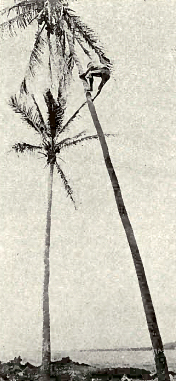Hawaii: It's People Their Legends
|
Preface The Hawaiian Race is universally recognized as foremost among those of the Pacific archipelagoes, and there is much in its history to arouse interest. With an unwritten record extending back 1,030 years, this people appeals to every student and observer. Gifted with an imaginative faculty well developed, a capacity to clothe thought in ornate language, and adorn recital with word picture, as well as a vocabulary that lends itself to poetic expression, the meles, or historical songs, are virile and have the swing of the trade wind. This volume is intended only as an appreciation of the people at large; a chronicle of some of the most striking legends, each of which points a moral. Aloha, the Hawaiian equivalent of affection, love of friends and family, patriotism and devotion, is breathed in every story, and sanctity of home, obedience to superiors and full justice are the mainsprings of each legend. There are many versions of these myths, and those here presented are given by the author as the commonly accepted ones. Mrs. Emma Metcalf Nakuina springs from blood lines which touch Plymouth Rock, as well as midseas islands. High priests, statesmen and warriors join hands in their descendants with pilgrims, lawmakers and jurists. Broadly and liberally educated under the immediate care of her father, a Harvard man, nephew of the late Chief Justice Metcalf of Massachusetts, Mrs. Nakuina is fitted to present legends which bring out strongly characteristics of her people. For purposes of reproduction in magazine or newspaper,
the copyright on the contents of this volume is waived. THE HAWAIIAN PEOPLE The Hawaiian people, according to Fornander, is a branch of the Polynesian race, had at one time affiliations with the peoples of Tahiti, Marquesas, Samoa, Fiji and New Zealand, is descended from the great Aryan race, and was originally white. Other theorists have boldly claimed that the Hawaiians are descended from one of the lost tribes of Israel, reaching the mid-Pacific through India, Sumatra, Java and the South Sea Islands. The writer, from knowledge of the customs of her ancestors, is disposed to accept the latter theory. It is reasonable to believe, knowing what we do of the peculiarities of the Israelites, their clinging to their beliefs and observances in the face of persecutions, their clannishness and arrogant assumption of being God's own peculiar people, thereby intimating that the rest of the world was the devil's own, would be sure to arouse antagonism as a race wherever they were. With the thrift which is a characteristic of the Jew from ancient time, the survivors of those that were dispersed and historically lost would very likely, as they made themselves useful to the people in whose lands they were as captives or otherwise, become rich and comfortable. They would, as circumstances permitted, naturally gravitate together, and, following the precept of their great ancestor Abraham, choose to inter-marry among their own people as far as in them lay. Unusually beautiful Sarahs or Rebekahs very likely were often sought and taken in marriage by the powerful and rich among whom they sojourned, as well as were Josephs desired by powerful men as sons-in-law, for their abilities, thus obtaining a mixed race. But it is reasonable to believe that the majority did as their Jewish brethren have done, and kept themselves to themselves. As they increased in numbers and waxed, rich, they would become objects of envy to the people around them, who would in time either expel them or attempt their destruction, as did the Egyptians to their forefathers, whereupon they would repeat the history of their ancestors and wander away from place to place. There were sun-worshippers among the original arrivals in Hawaii, and there were two temples dedicated to the sun on Oahu one at Kaneloa (a part of the present Kapiolani Park), and one at Kuaokala, Waianae. These temples were not for the whole population, but for only a few who claimed it as a privilege, the rest acknowledging it as such. These same peoples or tribes claimed kindred with the rest, but also claimed this right to worship the Sun and to expose their dead to the elements, in towers on a raised platform, after the manner of the Parsees with their Towers of Silence, as an especial privilege acquired by some of their ancestors through marriage. It is noteworthy that these customs were confined to a few of chiefly rank, and were not claimed or disputed by other chiefs.
The aboriginal Hawaiians were generally a tall, handsome people, of powerful physique; industrious, cheerful, kindly and hospitable to a fault. There were a few of short stature, mostly among the serfs the descendants of the captives acquired in the course of their migrations. Intermarriage between serf and commoner was frequent, and occasionally a mesalliance occurred where chief or chiefess lowered the standard of progeny by a union with a handsome man or beautiful woman in whose veins flowed the blood of a slave, though perhaps very much diluted. They had historians, genealogists, bards and poets, and all the concomitants of the mediaeval aristocracy of Europe or Asia. One or more families, in a tribe or clan, were generally set apart as genealogists of that particular clan, and it then became a hereditary office, to be handed down from father or mother to son or daughter, or, failing children, to a nephew or niece, who was adopted and instructed in the family genealogy of chief and clan. The genealogist was in every instance one who claimed a common ancestor with the head of the tribe, and thus would be expected to feel a proper pride in keeping correct the historical record of the chiefly unions, births and deaths, as well as those of the better class of makaainana or commoners.
Chiefs and commoners alike had to be trained in athletic exercises, to be proficient in the use of arms, and to keep their physical condition up to the highest standard, so as to be always ready to go to war at the behest of the chiefs, or to repel invasion by other clans or tribes. They were an industrious people. The chiefs always took the lead in any industrial project so as to keep the respect and allegiance of their people. They were tillers of the soil, with well-known rules and regulations for the cultivation and harvesting of every economical plant known to them. Skillful and daring fishermen, with a thorough knowledge of the habitat and habits of fishes; the seasons of their periodical migrations, spawning, etc.; and they had stringent laws and regulations for the taking of fish, looking towards their preservation. Fish were abundant in the waters surrounding the Hawaiian Islands in those days. Alas! the white man, with his alleged superior knowledge, prevailed on chief and commoner to throw down their wholesome restrictions, as savoring of superstition, with the result that fishes are very scarce in Hawaiian waters, and get ting more and more so every year. The tabu of the Hau, which meant the close season for shore fishing, to allow the amaama (mullet) and kindred fishes to breed and spawn undisturbed for six months, is no longer kept.
They were builders of beautifully proportioned and finely modeled canoes from the narrow light waa kialoa for a single fisherman, to the large peleleus, war and traveling canoes, single or double, of the chiefs, sixty to a hundred, and even a hundred and fifty feet in length, with a depth of from six to twelve and fifteen feet. I remember a pair of double canoes on my father's plantation that were over eighty feet in length. One had been broken in a storm through the unskillful handling of a foreigner. The unbroken mate was used singly, as a lighter to carry sugar from the plantation to schooners or steamers. The chiefs that is, the aristocracy and the commoners were generally of powerful physique. It is related of the First Kamehameha, that in battle he frequently took hold of an opponent, and, lifting him high over his head, would break him in half. This feat, to be sure, was not a very common one with the chiefs, and was peculiar to the Great Kamehameha, who very likely only indulged in it when such an act would be witnessed by and make its due impression on skillful warriors, who admired skill and strength united with personal bravery above all things, and whose allegiance and fidelity to himself he made secure in that manner. But all foreigners of observation who came to the islands in the early and middle part of the last century agree that the Hawaiians were a strong, athletic race. The change of habits and food, the compulsory clothing to come up to the white man's standard of civilization, and not least, the introduction of many new and formerly unknown diseases, with the vices of the white man, the negro, the Chinese and the Japanese, added to his own rather light and natural sins, have played havoc in too many instances with the splendid physique that was the Hawaiian's inheritance. The curse of drink in many cases transmits an enfeebled vitality to the children, and this, with ignorance of the ordinary rules of health under the present altered circumstances, very often causes a common cold to develop into a dangerous illness, when the ordinary foreigner would scarcely be inconvenienced by it.
The Hawaiian is hospitable. It is part of his creed, instilled into him for generations. The one supreme obligation of good manners with him is to invite whoever passes his door or approaches within speaking distance of him when he is eating, to partake of his food. There were professional story-tellers, relating tales of war or love, as well as legends, in which human beings were mixed up with supernatural ones, who at will took on human form, very much as in the Grecian mythologies, wherein Jupiter and Venus take on human form to indulge in love escapades with humanity. Should any of these story-tellers be possessed of a good voice for chanting the meles or songs that were an invariable accompaniment to any story or legend of any consequence, he would be doubly welcome wherever he should choose to visit.
These professional raconteurs generally roamed from place to place, unless they became attached as story-teller to the court of some powerful -chief, when they might not wander to other tribes or peoples without explicit permission. Every nook, cliff, valley or plain, as well as strip of
coast, headland or stretch of water, had its story or legend formerly,
and was noted for some heroic deed either performed by a hero or heroine
of long ago, or was perhaps the scene of the hapless loves of some
unfortunate youth or maiden. Lacking these, they were peopled by
strange, supernatural beings, who took on human form at will and
exercised great power for weal or woe over the human inhabitants of that
locality. Back to Contents THE GREAT BATTLE OF NUUANU
First in interest for scenic beauty and grandeur on the island of Oahu is the celebrated Pali of Nuuanu - This was formerly only a slight cleft or fissure near the top in the face of an almost perpendicular mountain range, forming the backbone of the island and dividing it into two habitable portions, the . windward and the leeward the Kona and Koolau sides, as they are locally known. There was formerly only a very slight and dangerous trail over the face of this precipitous mountain pass, and whoever ventured over it took his life in his hands. The trail could only be traveled single file, slowly and with exceeding care, for the breaking of a twig, or the crumbling of a small rocky projection forming a foothold, might send the traveler tumbling down the precipice to certain death. There is now a wide and beautiful carriage road leading down to the Koolau side, and unless one stands on the brink of the precipice, now safely railed in with strong iron guards and stanchions, one can hardly realize this was the scene of the terrible slaughter that took place over a hundred years ago. In the year 1795 Kamehameha the First, King of Hawaii, in pursuance of his policy of uniting the whole Hawaiian group under his sway, came with an immense army to Oahu to make war against Kalanikupule, king of Maui and Oahu, and son of Kahekili, the famous warrior king of Maui. Tradition, acknowledged by the later Kamehamehas as authentic, always gave Kahekili as the father of Kamehameha I. Thus Kamehameha, in making war on Kalanikupule, was contending against his own half-brother. It has been claimed by Kamehameha's adherents that he was justified in seeking for the sovereignty in any way, even at the "spear's point," as was the saying in those days, for their father Kahekili, wearied out by the continual struggle for supremacy with his famous son Kamehameha, had proposed to Kameeiamoku and Kamanawa, his elder twin half-brothers, who were also the foster parents by his own request of that son, that the latter leave him in peace for the rest of his days, and at his (Kahekili's) death, come after his (Kamehameha's) own. Kamehameha landed at Waikiki, the now favorite seaside resort, his immense fleet of canoes occupying the beach from Waikiki to Waialae, to the windward of Diamond Head.
Immediately on disembarking the army was formed in line of battle and marched to Nuuanu Valley to meet Kalanikupule. Several running engagements took place "between the opposing forces, commencing at the opening of the valley on the Ewa side of Punchbowl (Puowaina), then again at about the present cemetery sites, and around where the royal mausoleum stands. Finally the hostile forces met in a pitched battle at Puiwa, about two miles from the sea. The army of Kamehameha gradually gained the advantage, and the forces of the Oahuan king were pushed further and further up the valley. They tried to make a stand at Luakaha and at Kaniakapupu, the hill above, but were defeated by the superior forces under Kamehameha, and fleeing up the valley, were pursued and driven over the precipitous pali, thousands there meeting death. The victory was so complete that not one of the Oahu army that got into the upper part of the valley escaped. A young chiefess, the daughter of the high priest Kanaloauoo, whose residence was on Punchbowl crater, and who was connected with the Hawaii chiefs by the father's side, but whose mother was one of the tabu princesses of Kukaniloko, the famous cradle of Oahuan royalty, called her firstborn son Kaheananui, in mournful remembrance of the great heap of the slain Oahuans composed either of those who were driven and fell over the pali, or of the slain or wounded in battle who were hurled over the cliff by the victorious Hawaiians. The flower of the Oahu aristocracy perished in this battle, as well as the commoners, and the young chiefess referred to, though a mere child, was compelled by the victorious Kamehameha to be married to one of his generals, Nahili, whom he appointed to govern the conquered island on his return to Hawaii. Of course there was nothing but unquestioning obedience to the expressed wish of the conqueror, but she displayed her fidelity to her slaughtered kindred and people by calling her first-born, son of Kamehameha's own general and regent, Kaheananui (the great heap of the slain). It is related that Kamehameha, on hearing of this covert act of feminine defiance, only smiled indulgently and approved of her fidelity to the memories of the dead. Perhaps the fact that she was the descendant of a long and celebrated line of high priests, as well as of the tabu princesses of Kukaniloko on the mother's side, and was a powerful factor in keeping the Oahuans quiescent under the rather severe rules of her grim warrior husband, predisposed Kamehameha to overlook a tacit act of defiance, that, according to Hawaiian aristocratic usage, should have been punished by the death of mother and child. To this indulgence I owe much, as the chiefess Kalanikupaulakea was the great grandmother of the writer. Back to Contents
PELE, GODDESS OF VOLCANOES One of the versions of this famous legend, makes Pele the daughter of .Namakaokahai and the god Kane; in another, Namakaokahai is Pele's elder sister. They were fire goddesses who could, and often aid, take on human form at will, and contract marriages with human beings. Their original habitat was Ilao-o-Mehani, somewhere about the setting sun from here and about in a line with Java or the Philippines, probably Krakatoa. Namakaokahai was a very beautiful woman in her human form, and was the wife of the prince of the country where the volcano in which she held court was situated. But Pele her next younger sister was even more beautiful and the princely husband of the elder sister fell in love with Pele. Namakaokahai became jealous and demanded of their father, the god Kane and of their mother the Fire, the expulsion of Pele. This was granted by the god, in the interest of peace, as most human fathers of a large family would and this particular family of Kane was very large, numbering ten daughters beside the eldest and as many, if not more, sons. Pele must have been the favorite child of the divine pair, because all the nine younger girls were named Hiiaka and were subservient to her, as were also the dozen or more brothers, except her twin brother Kamohoalii. All the other brothers were called Kane, as Kane-hekili, Kane in the thunder, Kane-wawahilani, Heaven breaking Kane, etc.
It is believed the father god gave Pele especial powers over those god 'and goddess sisters and brothers as compensation for his having ingloriously given in to the demands of his jealous eldest daughter. Anyhow, whatever the reason, Pele was at the head of the expedition that left the mother country to seek a new home beyond the sea. Dragons, gnomes, serpents and sharks were ordered to go in Pele's train as servants and messengers or couriers. It is related that, having traveled a long way by sea, they came to a low, small island to the northwest, now called Nihoa. Her youngest sister and especial pet, Hiiaka-i-kapoli-o-Pele (Hiiaka in Pele's heart), was tired out, and besought her eldest sister to rest here a while. Pele consented, and immediately set to work to build herself a volcano house. She had not worked long when she gave up in disgust at the encroachments of the sea, and moved on successively to Kaula, Niihau and Kauai. Lehua was only a side issue, and originally formed part of Niihau. She found the climate, soil or surroundings of Kauai more to her taste, and made a comparatively long stay on Waialeale, in the mountains of Kauai. But the migratory habit or instinct must have become fully developed, and she left Kauai for Oahu, where she successively held court at Waianae, Moanalua, Puowaina (now known as Punchbowl), Leahi (now known as Diamond Head), and at Koko. Being so near Molokai, it was not long before she left Koko Head for Maunaloa, on the northwest half of Molokai. From here as a permanent court she opened up temporary residences at Kauhako, Kalaupapa, and also at Kawela, one possibly a sort of summer retreat and the other a seaside residence. After a while she found Molokai too small for her large family, and moved to the larger island of Mam. Here she first took up her residence on West Maui, and built up what is now known as the Lihau mountain, with an occasional excursion to Lanai, Kahoolawe and Molokini. After she had everything comfortable and the fires in good working order, she left the most of her family in charge of West Maui and moved on to the eastern portion of the island.
On East Maui she found conditions more to her
liking, and, in company with some of her relatives, set to work and
built up the beautiful round cupola of Haleakala (the House of the Sun).
Here she lived and worked for ages, until disgusted by the dissensions
and wrangles between those members of her family whom
she had left in charge of the Lihau fires. They had allowed the
fire to get beyond their control, which resulted in an eruption that
destroyed all the beauties and comforts of that home, so Pele left Maui
for good, and took up her residence on the slopes of Mauna Loa, on
Hawaii. Back to Contents PELE AND LOHIAU
Sometime after Pele had become domiciled in Kilauea, on Hawaii, she made up her mind to pay a visit to former home on Kauai. ohe took one of her two human forms that of the most beautiful woman in the world and had herself conveyed to the shores of Kauai by some means known only to herself, and there went up into the mountain of Waialeale. While she was there her rest was disturbed by the tumtum of a drum out on the plain of Haena. She went down and found that it was a drum being beaten to keep time for Lohiau, a prince of Kauai, who was dancing the hula olapa. She had a desire to take part in the gaities, so when Lohiau chanted the refrain of a song of his own composition, in the pauses between the dancing, she took up the stanza when he stopped to take breath, and taking the words as they were formed in his mind, sang the song, keeping accurate time and giving the appropriate gestures with each word. Lohiau was surprised, pleased, then enchanted with the beautiful singer. When the song ended he went up to the handsome stranger and invited her into the royal enclosure, offering her refreshments and food. After a very short courtship they were married. After living happily with him for some time, Pele informed Lohiau that she would have to return to her home, as she had some very important duties to perform. While she was enjoying her prolonged honeymoon, the fires of the volcano had been allowed to die down until there was just a little spark left in the very innermost recess of Halemaumau (the sooty house). She had never revealed to her husband that she was the Goddess Pele, though he instinctively felt that she was something more than an ordinary mortal; but he was content to love and be loved by the most beautiful woman he had ever seen, and could not bring himself to consent to a separation, even if only for a short time, as she kept assuring him. One day she disappeared, when, or how, no one could tell. Lohiau caused the whole population of Kauai to turn out and search for his wife, and after many months of weary waiting he became convinced that she had died; that probably she had been eaten up by sharks, as that seemed the only way in which she could so entirely disappear. Thus believing, he pined away, refusing all food or drink. When Pele had succeeded in restoring the fires of the volcano to their wonted activity, and had pacified or regulated her turbulent brothers, admonished her sisters and commended the youngest, her pet and loved one, for her faithful endeavors to keep alive the fires that were but offspring brought from their mother fire from Kukulu-o-Kahiki, she had time to turn a backward glance to the faithful husband she had deserted on Kauai. She perceived that Lohiau was at the point of death, and, filled with sorrow and love for the handsome mortal whose entire love she had won, she called her little sister Hiiaka-i-ka-poli-o-Pele, and telling her of Lohiau and of his dying condition, requested her to go to Kauai and bring the prince to Kilauea. Hiiaka's human form was that of an extremely beautiful maiden just verging upon womanhood, whose beauty was second only to that of Pele herself. Being the pet of the dread sovereign of the volcano, or possibly on account of her youth, she had been allowed a good deal more liberty and freedom -of action than the rest of the gods and goddesses. She was very fond of humanity, and assumed as often, and kept as long as she could, her human form. She had many human friends, and was on particularly cordial terms with her own devotees, frequently joining in the songs, dances and feasts celebrated in her own honor. She had three very dear, bosom friends (aikane) that she loved above all beings except her august sister. One Hopoe was a famous hula girl, who danced at the religious celebrations in honor of Pele and her brothers and sisters. The others Paupalai and Wahineotnao were semi-divine beings, the offspring of some of the volcano gods who had taken human form, and beautiful women who happened to capture their fancy. Hiiaka went to the Lae-o-Kumukahi where Hopoe dwelt, and spent a day in the sport of surf-riding with her friend. At dusk she told her of the mission on which she was to go, and earnestly besought her not to marry during her (Hiiaka's) absence, as she wanted to find her friend unchanged upon her return. She was enjoined to be faithful in the observance of all religious exercises, and to think very often of Hiiaka, as thereby she would be strengthening the goddess during her long and perilous journey. Hiiaka took Paupalai and Wahineomao to be her companions and attendants on her journey. These two had the advantage of being able to render themselves invisible to ordinary mortals when Hiiaka so desired, and therefore in some respects were more desirable traveling companions than Hopoe. Hiiaka had to travel in human form, subject to the conditions of all mortals, and to the dangers and fatigues attendant on such a long journey by land and sea. Many perilous and exciting adventures befell her "before she reached Haena, the home of Lohiau. When she arrived at Haena she found Lohiau had been dead for an anahulu (a fortnight), and that his body had been put in the puoa, or Tower of Silence, and was being faithfully guarded by relays of devoted attendants day and night. She waited until midnight, then praying to her father Kane for help, she caused a deep sleep to descend on the guards, and entering with her two attendants, they carried the body of Lohiau to the cave called Ka-wai-a-ka-palae, and there performed the rite of the kakelekele over the body. Just before dawn they returned it to the puoa. The attendants, on awakening at dawn from their deep sleep, and hastening guiltily to look at the body of their beloved chief, to assure themselves that no one had committed desecration by stealing a limb to use the bones to make fish hooks, were amazed to find all appearance of decomposition gone, and that Lohiau lay as if in a natural sleep.
The next night Hiiaka went through the same performance, and the attendants on awakening found the body of Lohiau still more lifelike. They consulted the high priest, but as he was himself in retreat, he could not come to the polluted puoa, but advised them to use every effort to keep awake, assuring them of his belief that a miracle was being performed, and, he suspected, through the agency of Lohiau's unnaturally beautiful wife, who had so strangely disappeared. The high priest cut short his own religious observances and declaring himself noa, joined the watchers on the fourth night. Hiiaka as usual cast her sleeping spell over the attendants, but could not prevail against the high priest, who belonged to the cult of Kane, her own father's worshippers. So on entering as usual for the body of her sister's husband, she was confrpnted by the high priest. She explained everything to him, and assuring him that only the fact of his being engaged in the observance of the worship and duties due to her father prevented her from calling on him for assistance. She then pressed him into service and together they all bore the body to the cave. Here the last kakelekele was performed, and the purification, internal and external, being complete, Hiiaka calling on Kane, her father, the source of all life, breathed into Lohiau's nostrils four times and he was restored to life. But he was still very weak from the long fasting he had undergone and he had to be carefully fed and nursed. The attendants bore him secretly to the high priest's house and Paupalai was sent by Hiiaka at dawn to gather the dew from awa leaves into a gourd, for a drink for the resuscitated man, and Wahineomao was directed to gather ulei and mamaki berries from the mountain ravines. The juices of these, pressed through cocoanut fibres, were the only food given him at first, with the dew for drink. After some days, Paupalai was sent to the naele o Aipo to get the kalo poni-a-Kanaloa and the luau Lauloa-a-Kane to make luau and kalo pulehu (roasted taro) for a more substantial diet. An anahulu afterwards he expressed a desire for some oopu-peke-o-Hanakapiai. These were procured and when he had made a meal of these and poi, his cure was pronounced complete, and he showed himself to his faithful subjects. The rejoicing throughout the island was great, and many feasts were given and attended by Lohiau and Hiiaka, whom the populace knew only as the sister of their beautiful princess who had so mysteriously disappeared. The high priest, by order of Hiiaka, was given the credit for the miraculous restoration to life. After a month of feasting, games and sports of all kinds, Lohiau bade good bye to Kauai, telling his people he was going to meet and bring back his wife, and started for Oahu in a pair of double canoes, beautifully decorated, and attended by a small fleet of canoes, containing his attendants and provisions, also presents for the loved wife and the new relatives, whose acquaintance he expected to make. They were royally received and treated on the different islands which they touched on their wray to Hawaii. Of necessity the many attentions Lohiau and. the beautiful princess received, took up a good deal of time. These civilities were from the highest chiefs and might not be lightly refused by Lchiau. ruler of an island subject to invasion, and expecting to come back from Hawaii some time in the near future with his wife. So like a prudent husband and ruler he was not going to make enemies by disregarding or not giving proper time and attention to the hulas, surf riding, maika, and numerous other games given in his honor. The journey consumed many months and his dread wife began to be restive, indignant, suspicious and finally jealous of the travelling pair. She believed her sister could have hurried back to the volcano, bringing the husband that Pele dearly loved, despite her desertion. When the pair arrived at Makea, in Hilo-pali-ku, the anger of Pele could no longer be restrained, and incensed as she was with her former favorite sister,, she was provoked that Hopoe (Hiiaka's aikane) continually chanted the praises of Hiiaka. Hopoe had composed many songs in honor of her beloved goddess friend, and spent much time in practicing new steps, movements and gestures for them, to be used at a grand feast when Hiiaka returned. In her enthusiasm to prove to Hiiaka how entirely she had complied with the Litter's request to remember and think of her, she had in a measure somewhat neglected the customary dances in honor of the older goddess. Pele, in her jealousy, seizing this as an excuse for destroying this one, loved of her sister, suddenly appeared af Kumukahi and changed Hopoe to stone, all the priests and attendants devoted to the worship of Hiiaka being treated likewise. Hopoe had just gone to have a sea bath, and such was the vindictiveness of the jealous goddess, that when she changed the unfortunate young woman to stone, she had her affixed permanently to a stone base, but so nicely adjusted on what appeared to be a natural pivot that with every movement of the waves the body rose and fell or swayed as if in the graceful undulations of the hula. On the arrival of the belated travelers at Kukuilauania, a mile beyond Afakea, Hiiaka saw the smoke of the destruction of Kumukahi. Her heart misgave her, and projecting her spirit to the scene, she saw, and understood, the cause of her sister's work of destruction. This took only a moment of time as she stood by the side of Lohiau and gazed at the fire and smoke ascending from Puna. When her spirit returned to her body, she broke out in a wail for her dear playmate and companion in many a long day of surf riding, surf canoeing and hulas. She there and then poured out her sorrow in a song of great beauty and pathos that has been the standard of perfection for Hawaiian poetic compositions ever since. In it, she recounted their days of companionship from Hopoe's earliest childhood; their simple pleasures and the sylvan beauties around the scenes of their childhood wanderings and sports; the dangers, excitements and pleasures of surf riding and canoeing shared together; the ardor and fidelity of the young maiden in learning the dances in honor of and to be performed in the worship of Pele; Hiiaka's sorrow at being compelled to leave her and all that made life pleasant, to obey the mandate of her sister to go after the deserted husband and the fidelity with which she had executed the order, in the face of great obstacles; the purity of her heart and mind towards her sister's husband; the long, wearisome and dangerous journey almost completed, and now, her reward, on the very threshold of their dominions, to witness the destruction of the one dearer to her than any other.
Lohiau listened to the song in amazement, and for the first time a realization of the dread nature of his wife came to him. He was also filled with a great pity and compassion for the young and sorrowing girl who had been the means of restoring him to life, and what was of more consequence to him, was taking him to that wife so dearly loved that life without her had become unendurable. When Hiiaka ceased her chant, she turned to Lohiau and deliberately kissed him, at the same time telling him it was the kiss of death. Lohiau returned the kiss, embracing her warmly in what was to him a purely fraternal manner. Hiiaka informed him he was to continue his journey to his wife's home under the guidance of Wahineomao and Paupalai, as she had to leave him to go to mourn the death of Hopoe and all the priests devoted to her cult. Leaving him instantly with that farewell kiss, she hastened in her proper form to Puna and commanded her sister to cease her horrid work, as she had made destruction enough. She ordered her to go back to her home at Kilauea and there give befitting greetings to the husband for whose sake she (Hiiaka) had to undergo so much, to be rewarded by the destruction of all she held dear amongst humanity, and was obeyed. In due time, Lohiau arrived at the edge of the crater of Kilauea, and chanting a salute to Pele, awaited the answer. The only answer was for her to order her brothers to set him on fire from the feet upwards, but for them to endow him with added hold upon life, that he might thus endure greater agonies. This spiteful order was carried out, some of Pele's attendants in the meantime accusing the unfortunate man of his supposed infidelity with Hiiaka. Lohiau warmly denied the imputation and reciting the story of his search, grief and death for Pele, ended by saying he could but die, but with his last breath and while consciousness lasted he would still love Pele and would so proclaim to them. Kane, from whom all life emanated, he declared would be his judge. This reference to their father convinced Pele's brothers of Lohiau's purity, and they begged of their sister to stop her persecution. Pele ordered them to go on, and they flatly refused, telling her to kill her lover herself if she was so blinded by her insane jealousy as to be unable to perceive the truth of what he was affirming. She then ordered her sisters to perform the terrible deed, sending them to him one by one, as each would retire, filled with pity and compassion for the faithful, loving heart burning to death to satisfy the unreasoning hate of a jealous goddess, just as if she was only an ordinary woman. Each applied a touch of fire and then retired to unite their entreaties to those of the brothers. But Pele was deaf to all their entreaties, wishing and hoping Hiiaka-i-ka-poli-o-Pele would also intercede. When there was but a little spark of life left in Lohiau, the elder sisters, realizing Pele's desire for the former favorite sister to humble herself, hied themselves to Kumukahi, where Hiiaka mourned her dead, and besought her to come and save the life of her companion in the long journey from Kauai. The answer was characteristic : "No, I will not. Convinced now of the absurdity of her suspicions, she would like an excuse to restore her lover; but what of my loved ones? What of my faithful and devoted priests? She will not restore them. Who will there be now to pay devotions to me, so as to supply me with strength to do my duty to humanity? Pele was always jealous of my mortal friends, while I willingly assisted her to what should have been a full realization of a happy married life during the natural duration of that man's life. Let him die. She loves him yet, and so she will mourn for her loved one while I mourn for mine." And so Lohiau died. It is asserted that Pele, realizing her folly and
cruelty to both husband and sister, took an oath that never more would
she dally in love with mortal. And it is furthermore told that, overcome
with remorse, the great Goddess humbled herself to her petted younger
sister, asserting that in taking up the human form she became subject
and liable to all the frailties and weaknesses of humanity. The sisters
were reconciled and there and then made a solemn vow that they would in
the future have no more intimate relation with mortals than as
divinities and devoteees.
Back to Contents THE VALLEY OF RAINBOWS
Kahalaopuna was the daughter of the chief of the district that included the beautiful Manoa Valley within its boundaries. These boundaries were varied from time to time at the pleasure of the reigning monarchs or through the exigencies of war. She had been betrothed from childhood by her parents to the young chief Kauhimahu, commonly called Kauhi, son of the chief of Waimanalo, Kailua, Kaneohe and Heeia. As the future bride of the son of such an important chief, the fatherin-law prospective demanded that the child be brought up in the strictest seclusion, seeing the face of no man but her own immediate relatives and attendants, until she was married to his son. This was agreed to by Kahalaopuna's parents, the child even then giving promise of the rare beauty for which she was afterwards celebrated. As she grew up the radiance emanating from her beautiful person was such that it cast a roseate glow in the air around her. With all her beauty, she showed such a spirit of humility and obedience to her parents and guardians, and of love and consideration for her attendants, that the staid old gods Kane and Kanaloa themselves fell in love with her, and sent the rainbow to play continuously around her home as a sign to all people that there dwelt one who was especially favored of the gods. Her attendants and relatives were so proud of her beauty that they were continually singing her praises, and countless meles or chants were composed in her honor by enthusiastic retainers. Kahalaopuna is the first beauty of Manoa mentioned in history or legend or song, and was the precursor of a long line, until the valley became commonly known as the valley of beauties, "Ka ui o Manoa." Two men, mountaineers, dwelling on their little patrimonies with few retainers, in the eastern corner of Manoa Valley, called respectively Kumauna and Keawaawakiihelei, listened to the chanting of the songs and the praises of the lovely princess of Manoa, until they conceived a wild and passionate love for the beautiful, although unseen, maiden. They knew there was not the slightest hope of either possessing the object of their fondest desires, as one was disfigured by a humped back, and the other, although possessing a tall, finely proportioned figure, had one eye injured in childhood, the lower eyelid being turned in such a way as to display the inner red membrane. This condition of the eye is called by the natives maka-helei, and is considered a more hopeless bar to love response from the opposite sex than any other form of personal disfigurement. These men were great friends, and confided to each other their passion for Kahalaopuna. They determined that if they could never possess her, at least they could pretend to the world that each had at different times been favored with her love. They went about bragging of the conquest each had made of the famous Manoa beauty, until their story eventually came to the ears of Kauhi, to whom she was betrothed. His was a very suspicious nature, and he believed the wicked story. He was deeply wounded to think that his promised bride, brought up with such care and in seclusion, and the fame of whose beauty had gone throughout the group, should so demean herself as to hold any intercourse whatever with those two disfigured men, let alone grant them the favor of her love. The blow to his pride and vanity was so great that he determined that nothing but her death would wipe out the disgrace. Accordingly, unknown to either his own or her parents, he came over the pali of Kailua accompanied by the old kukini or runner, whom he had always employed as a messenger to carry messages or presents to his fiancee, and therefore was well known to her, as well as to her immediate attendants.
He arrived at her home in due time, made himself known and demanded that she go with him immediately to his home across the mountains. Kahalaopuna, knowing she had been affianced to him from early childhood, obediently followed him. He sent her attendants the round-about but usually traveled route by way of Punchbowl Hill, while he took Kahalaopuna on a trail across the mountains between Manoa and Nuuanu Valley that would eventually bring them out at Kaniakapupu above Luakaha. They crossed over the Manoa streams, and went up the slopes of Aihualamaiki adjoining Kahaumakaawe. This slope was formerly covered by a grove of Koa and Lama trees. Near a large rock half way up the slope, Kauhi killed the girl by a blow on the head with a bunch of hala nut which he was carrying, ostensibly to make leis for her. This bunch of hala had been sent as a token of love to the young chiefess by the venerable high priest of Kaualaa, and came from the sacred groves on the windward of the heiau (temple) of that name. Tradition has it that the gods were so shocked at the murderous use to which their sacred hala had been put that they cursed the trees, and the splendid and lovely grove of Hala, Kukui, and Wiliwili of Kaualaa and Mahinauli died in a single night. After Kauhi had killed the beautiful maiden he covered her body with the leaves of the Akolea, a coarse species of fern, and kept on his way, climbing the mountain in the northern corner of Manoa. Half way up the mountain he heard the voice of Kahalaopuna crying to him and chanting a song, wherein she beseeched him to test her fidelity before believing anything against her. An owl god which was her deity had seen the murder committed, and brushing the covering of leaves aside, had kissed her wounds and made them whole, and breathing into her nostrils, had restored her to life. The girl, strong in her knowledge of her innocence and purity, would not let her affianced go with such a mistaken opinion of her, and kept calling to him in her song to prove her fidelity. Kauhi pretended to believe her, and called her to come to him, and together they went up the mountain side. But after a while his anger overcame his love, and he killed her again. It was the belief of the mountaineers of the olden time that the spirit of the murderer Kauhi haunted the trail between Manoa and Nuuanu, and that often maile and fern gatherers were startled by a faint and mournfully sweet song chanted by the spirit of Kahalaopuna, and the answering despairing wail of Kauhi, "O, my wife, come back to me! I was Wrong!" "E ku'u wahine-e, hoi ma-i. Ua hewa wa-u." In the eastern corner of Manoa Valley can be seen the peak of Kumauna, with a hump on the back of the ridge leading up to the peak, and alongside of it the ravine of Keawawa-Kiihelei. These places belonged to and are called after the two wicked men who were the cause of the sad death of Kahalaopuna. And when the gods realized that their favored maiden had been murdered, they decreed that the rains should fall daily about the valley of beauty, their tears in memory of her graces. Back to Contents
LEGEND OF KALIUWAA
On the windward or Koolau side of Oahu, about
twenty-eight miles from Honolulu, is the beautiful little valley of
Kaliuwaa, the some time borne of the Hog God, Kamapuaa, and the scene of
many adventures. On the side of the ravine is a hollowed out depression
in the form of a canoe. It is said this was formed by the pressure of
the god's body after he had told all his family, retainers and all, to
mount his back with their goods that he might deliver them from the
soldiers of Olopana, King of Koolau. The hog-god was very mischievous,
and had been in the habit of stealing the poultry belonging to the king,
eating all he wanted and carrying the rest home to his family. He had
also devastated the potato and kalo plantations, and thus had stirred up
against him the enmity not only of the king, but of all those who
directly or indirectly subsisted on the king's bounty. When the army of Olopana was perceived turning mountainwards from the beach at Kaluanui, Kamapuaa was asleep beside a large rock very near the house of his grandmother, Kamaunuaniho. The advance guard of the king's army arrived at the little settlement that was Kamaunuaniho's patrimony, and began running in and out of every house searching for the fowl thief, who just before detection had changed to his ordinary human form. On arriving at home Kamapuaa had resumed his hog form. The search was for some time unsuccessful, but two men who were up on the ridge above the house shouted down to the searchers: "There he is, right by that big rock ! We saw him lie down there a little while ago on his arrival on a dead run, while we could see you people far behind chasing him. We have been watching ever since, and have not seen him get up or go away." The people looked and finally shouted up, "There is no human being here! Only a large fat hog!" "That is the one," they answered back, ''That is Kamaunuaniho's pig, and he must have been the thief." These loud words shouted back and forth aroused the hog, and, grunting, he stood up and looked stupidly at the people surrounding him. The latter were pleased to find so large and fat a hog, and tying a rope around his neck, led him down towards the main body of the army with the intention of presenting their prize to the king. They made many remarks on the way down of the feast that they anticipated would be given, with their fat prize as its main feature.
Kamapuaa went down the valley tamely enough until he came up with the main army, which was still some distance away from his home, so as to spare his grandmother, in a measure, from the scene of violence and carnage that was to ensue. When he had arrived at what he judged was a proper distance, he suddenly turned and tore his captors to pieces. His body swelled visibly, and his hide roughened and toughened, his bristles becoming hard and stiff as so many spikes. The spears hurled against him by the well-trained soldiers of Olopana rolled off his sides as if they were so many flowers being pelted upon a returning hero. He bit, struck down and tore open the soldiers of Olopana, and in a very short time had wiped out the larger portion of the army, the king with a few men seeking safety in ignominious flight. Kamapuaa, after routing the enemy, sought out his beloved grandmother, who, with her few trembling retainers, had fled into the upper part of Kaliuwaa Valley, as far as the lower falls, and were anxiously awaiting trie outcome of the strange conflict between trained human fighters and her supernatural grandson, who had been the original mischiefmaker, and must now be her protector. He told his grandmother that he was going to take them up on the upland above Kaliuwaa Valley, as Olopana would undoubtedly gather another army and come again, and he wanted his grandmother and her people to be in a place of safety, so he would be free to act as it seemed best to him. Kamaunuaniho agreed to do exactly as the hog-god told her. The hog then pressed his back against the perpendicular face of the rocky defile, and his body began to enlarge and elongate, until his hind feet rested on the ground at the base of the cliff, and his head rested on top of the table land above the ravine. Kamaunuaniho made her servants go up first with all their household utensils and necessities, they climbing up by holding onto the hairs. When they were all up he reduced his size, and then made his grandmother sit astride his neck, whereupon he gently arose on his hind legs and elongated his body until she could step off from his neck on to the high land. The two remarkable trough-like depressions on the face of the precipitous mountain side are the marks of the erosion caused by the pressure of the hog god's body when saving his people. They are called waas (canoes) by the Hawaiians, and gave the name to the valley from their fancied resemblance to two immense canoes standing on end. It is related that after Kamaunuaniho and her people had time to look around, after finding themselves in a place of comparative safety, they perceived that the two men who had given information to Olopana's soldiers from the mountain ridge as to Kamapuaa's whereabouts, were still in the same positions and attitudes as when they shouted down their directions earlier in the day. On investigation it was found they had been turned into stone, and there they remain to the present day, a warning to busy-bodies for all time. Kamapuaa subsequently conquered most of the island of Oahu, and, installing his grandmother as queen, took her to Puuokapolei, the lesser of the two hillocks forming the southeastern spur of the Waianae mountain range, and made her establish her court there. This was to compel the people who were to pay tribute to bring all the necessities of life from a distance, to show his absolute power over all. Puuokapolei is some little distance from Sisal, towards Waianae, and is as desolate a spot as could be picked out on the whole island. It is almost equally distant from the sea, from which came the fish supplies; from the taro and potato patches of Ewa, and from the mountain ravines containing the banana and sugar cane plantations. A very short time ago the foundations of Kamaunuaniho's house could still be seen at Puuokapolei; also the remains of the stone wall surrounding her home. It has even been said that her grave could then be identified, but since the extension of cane and sisal planting to the base of Puuokapolei, it is possible that the stones may have been removed for wall making. Back to Contents
KOAPULUPULU AND A PROPHECY
It was here that his family usually lived, and that he was wont to retire for relaxation from his duties as high priest, prime minister and chief councilor in state affairs. He was here when he saw and heard, by means of his wonderful powers of second sight, corresponding, it is supposed to our modern telepathy, the kings Kahekili of Maui and Kahahana, his own sovereign, plotting to get rid of him. As soon as orders were given by Kahahana, at Waikiki to send a picked corps of soldiers to kill Kaopulupulu at Waimea, the latter, though more than fifty miles away, heard it; and recognizing the futility of resisting the combined authority and enmity of the two kings, ordered a feast prepared immediately. When ready, he partook of it with all his family and retainers as a farewell supper. When the meal had been enjoyed, he acquainted his people with the fate in store for him and advised a quiet submission to the powers that be, to avoid useless loss of life. His own family that is, his wife and children he ordered to accompany him over the mountains to Waianae so that none of their dependents would be involved in the slaughter that he knew would result. The people of Waianae were dependents of another chief, consequently would be regarded as neutrals by the king's party. Kaopulupulu and family were pursued by the king's soldiers and overtaken at Waianae. They were immediately set upon, and he, wounded unto death, called to his eldest son, who was bravely fighting against overwhelming odds, "I nui ke aho a moe i ke kai, no ke kai ka hoi ua aina." Freely translated, "Be strong and strive to get to the sea, and die in the sea, when the land will then belong to the sea." The son did succeed in fighting his way to the sea, which he entered until the water was up to his armpits, before he died of his numerous wounds. Kaopulupulu's call and advice to his son has been regarded and accepted by all Hawaiians in the nature of a prophecy, presaging the utter extinction of Oahu's autonomy as an independent kingdom. Some believe that the effects of the prophecy will go on forever, and that whoever will exercise sovereignty on Oahu will eventually be superseded by some power from over the seas. So far, since 1783, a hundred and twenty years ago, four changes of government, or rather of the personnel of the governing people, have occurred, and always in the line of advent from over the sea. First after the death of Kaopulupulu, Kahekili, King of Maui, and uncle to Kahahana, waged war against him, defeated him and had him put to death, when Oahu then became tributary and an appendage of the kingdom of Maui. After Kahekili's death, Kamehameha came from Hawaii and waged war on Kahekili's son and successor, defeated him in the bloody and decisive battle of Nuuanu, elsewhere related, and the sovereignty went further beyond the sea to the Kamehamehas, kings of Hawaii. After the Kamehameha line became extinct, the white people from over the sea seized the sovereignty and instituted our late Provisional Government and succeeding Republic. The United States, a power from far beyond the sea, needed Oahu, and she, with the successive powers that had from time to time annexed her to them, was now annexed by one from way, way beyond the sea. Did a vision of all these happenings flash on the sight of the remarkable old seer of a hundred years ago? And was this all? Or were there more scenes, as yet unenacted, when mayhap the exigencies of circumstances may cause the United States to give or abandon us to the Northern Bear, or to some great Asiatic power that may yet arise? Back to Contents
KAULULAAU AND LANAI Kakaalaneo, King of Maui, has always been famed in Hawaiian traditions as the first king of that island who gave his attention to agriculture and the promotion of all the domestic and peaceful arts, and his reign has always been looked upon as the golden age of Maui's kingdom. He it was who planted Lahaina, formerly known as Lele, with ulu trees (breadfruit), and the place became famous in story and song as the "Malu ulu o Lele." "The shady breadfruit grove of Lele." As the place is situated at the base of and leeward of the Lihau range of mountains, where very little rain falls, and is more or less shut off from the cooling influence of the prevailing trade winds, one who is a kamalina can fully appreciate the cool, grateful memories evoked by the mere mention of the "Malu ulu o Lele." Breadfruit was a very important article of diet among the ancient Hawaiians, and when in season, chiefs and commoners alike abandoned the use of taro poi for breadfruit poi, claiming that such a change of diet was beneficial on account of its alterative effect on the system. In the days of Kakaalaneo, breadfruit trees were a very valuable possession, and to plant one was a meritorious act, worthy of commendation by one's superior. To plant a grove, even if only a small one, was an act worthy of the gods, entitling the planter to the grateful remembrance of posterity, whose duty it was to compose and sing songs of praise in his or her honor. It was the same if the grove was a cocoanut one; and conversely, to cut and destroy one tree, either breadfruit or cocoanut, merited death. To destroy many was a declaration of war, and a war of extermination at that, to distinguish it from a war entered into for honor, glory or profit. To return to the subject of our story, Kaululaau. He was the son of Kakaalaneo and his queen, Kanikaniaula, who was the first maker of an Ahuula, the famous netted feather capes and cloaks of these islands. Kaululaau should have been the heir apparent to the kingdom, but he was so wild and eccentric that his father declared he had forfeited his rights, and banished him to Lanai, which at that time was inhabited by a race of ogres, gnomes or goblins.
The prince, then only ten years old, was stronger than many a full-grown man, but had in most respects the intellect and desires of a child of his age. He slipped out night after night, after every one was asleep, and wrenched out trees, roots and all, from a certain space he wanted to clear for a playground, so he could indulge in the pastime of ke'a pua The throwing or slinging of sugar cane blossom arrows unobstructed by the branches of the trees. The king, chiefs and people were very much incensed at the destruction of the trees, and a watch was set to find out what unnatural monster was doing such a wanton act, depriving people of the abundant staff of life their industry and the favor of the gods had provided. When it was found to be his own son, the king, with a prudent regard for the anger of his people, added to his own indignation and sorrow at the destruction of his favorite trees, had no option but to banish the lad to Lanai where he could have the congenial company of goblins and ogres, and could exercise his great strength in righting out his own salvation with them instead of using it in pulling fruitful trees from the ground.
Kaululaau was accordingly taken over to Lanai on one of his father's double war canoes and landed at Kahalapalaoa. Such was the detestation and horror in which he was held, on account of the wanton destruction of what meant life to many people, that not a servant or retainer would volunteer to share his exile and danger, contrary to the well-known and customary fidelity of Hawaiian nurses, or kahus, to their chiefs and nurslings. It would take too much space to recount in detail the many battles waged by him with the demons, but suffice to say he came out victorious in all and finally exterminated or reduced to servitude all the goblins and other inhabitants of the island. When he had reduced the last goblin or demon to subjection he set them to building a stone wall to enclose a fishpond for him, and to clearing and planting patches of potatoes along the sea beach, and of upland taro in the mountain ravines, as he had become tired of living exclusively on noni and fish. The goblins having either disappeared or become subject to Kaululaau, fishermen from Maui, Molokai and Oahu, who frequented the famous fishing banks of Ka-pali-a-ka-holo to leeward of Lanai, came ashore, were made welcome by Kaululaau and given potatoes, taro, sugar cane and bananas in return for such fish as he needed. The news of his success in subjecting the supernatural inhabitants of the heretofore dreaded island and of his generosity to fishermen quickly spread through the islands, and on invitation, many fishermen brought their families with them and located permanently on Lanai, swearing fealty to Kaululaau as their prince. Tradition has it that he made a wise and generous ruler, greatly beloved by his subjects. Kakaalaneo was the last to hear of the success and reformation of his wayward son, and as soon as he did, yielding to the entreaties of his queen, Kanikaniaula, they sailed to Lanai to pay him a visit. He received his parents with every mark of humility and affection, offering the redeemed island of Lanai as his indemnity to the Maui king and people for the uprooted ulu trees. Lanai from that time became an appanage of Maui. Kaululaau took his place as if a younger prince royal, and steadily refused to return to Maui, or to take the sovereignty of the islands at the death of his father. Back to Contents
DEFEAT OF THE ALAPA Wailuku was, in 1776, during the reign of Kahekili as king of Maui, invaded by Kalaniopuu, king of Hawaii and brother-in-law of Kahekili. The Hawaii regiment, called Alapa, every member of which was from the highest aristocracy of Hawaii, wearing their helmets, short capes and girdles of yellow, red and black were sent by the Hawaii king to take Wailuku, and, as they facetiously expressed it themselves, "to drink of the waters of lao," the beautiful stream that flows through Wailuku. They were met and literally annihilated by the Maui forces under their celebrated warrior king, Kahekili, who, to the knowledge of the writer, always has been claimed by the later Kamehamehas as the own father of Kamehameha the Great. So complete was the destruction of this famous regiment of the Alapa, which was considered the bravest and best, as well as the flower of the Hawaiian warriors, that only two out of eight hundred escaped, and these two, covered with wounds, were ordered spared by Kahekili himself, to be, as he ironically expressed himself, "ahailonos" (talebearers) to the Hawaii king of the fortunes of the day. This battle is called the "Ahulau ka piipii i Kanikanilua."
In 1790, Kamehameha, nephew of Kalaniopuu, and who had in the meantime become king of Hawaii, invaded Wailuku for the purpose of avenging the fate of the brave Alapa. The fight commenced at Wailuku and extended up the valley of Iao. It was fully as sanguinary a fight as had been the former one of the Alapas, but this time a master mind planned and directed the moves in the battle for the Hawaiians, and the wise and experienced, but aged, Kahekili was absent on Oahu, and victory rested with the Hawaiians. The Maui troops were completely annihilated, and the corpses of the slain were so many as to choke up and dam the waters of lao, and thus the battle is known in history as that of "Ke pani wai" (The dammed waters). And beautiful Iao Valley has since been known by the title of "Ke-paniwai," and is thus always referred to in song or story. Lahaina was formerly the only seaport of the island of Maui where vessels of foreign build could lay or enter. In the forties and fifties it had a considerable trade with whalers, and at one time was the royal residence and center of government, and consequently the capital of the kingdom. It was here that the first Hawaiian Constitution was framed and constitutional government proclaimed in these islands. Kauiki, in Hana, East Maui, was a famous fort of the olden time, and was always a bone of contention between the Maui kings and those of Hawaii. When Kamehameha Nui was king of Maui, Kalaniopuu captured this fort, and it was held as an appanage by the king of Hawaii from 1759 till about 1781 or 1782. It was recaptured by Kahekili, the younger brother and successor of Kamehameha Nui, the king of Maui. Back to Contents
KAMEHAMEHA'S LAST HEIAU Kawaihae, on the west and leeward side of the island of Hawaii, was in the olden times, and as late as thirty years ago, a place of considerably more importance than at present. It was in those days one of the principal seaports of the island, and is famous in history as the place where the last heiau, or temple to the Hawaiian god, was built by Kamehameha the Great.
It was to the consecration of this heiau that his cousin, Keoua-ku-ahuula, the independent prince or chief of Kau and South Kona, was coming on Kamehameha's invitation, when he was treacherously set upon and murdered by the chiefs of Kamehameha, with the latter's connivance and approval. The body of the unfortunate prince was the first offering made by Kamehameha himself at the opening and dedication of the heiau to his war-god, Ku-kailimoku. The writer possessed a piece of wood from this celebrated war-god a few years ago, but one of her children falling very ill with typhoid fever, the family servants and retainers would have it that the illness was caused by the presence of this piece of the god, and one old lady who had long been the custodian of the same for the family, risked her life, in her own estimation, to save that of her young chief. While the writer slept, after watching, the other retainers were ordered to build a large bonfire, and when it was blazing merrily the piece of the god was thrown into the fire, where of course it was consumed. The boy the present Speaker of the House of Representatives recovered when at almost the point of death, but two months afterwards the faithful old retainer was seized with paralysis and died within three days. After the attack, and while still retaining in a measure the power of speech, she told those surrounding her she knew her sickness was the punishment of her crime in destroying the last known piece of the god, which had been confided to her care for the writer by her hakus, the writer's ancestors; but that she was content to die, as thereby she had saved her young alii's life. She was but a type of the real old kahus of former days the genuine ones not those who had attached themselves only for the food, clothing or pleasures to be experienced at what they call "ke alo o na alii" ("in the presence of the chiefs"). Kailua, the next seaport south of Kawaihae, was a favorite royal residence under the Kamehamehas. The large stone walls that enclosed the residence of Kamehameha the Great, where he died, and which is called Kamakahonu, were still to be seen three years ago, although most of the stones from the mauka or landward side had been carted away, evidently for the making of piers or buttresses for the wharf that extends in front and parallel to what was the entrance and altar to the temple for family devotions in the royal enclosure. Back to Contents
KEALAKAKUA BAY: CAPT. COOK
This bay is famous as the place visited by Captain Cook, the discoverer of these islands, and it was also the scene of his death at the hands of an outraged people. The British government some years ago erected a monument to his memory on the spot where he fell.
The Hawaiian people, as a whole, never felt particularly grateful to Captain Cook for discovering them to the European civilized world, nor do they hold his memory in any very great esteem. The famous Hale-o-Keawe was situated further down on the coast, but was destroyed long ago on the Queen Dowager Kaahumanu and her alleged stepson, the second Kamehameha, adopting Christianity. Hale-o-Keawe is the ancient house of the gods. Back to Contents |
||
|
|
|
|
|
|
||
| History | Atlas | Culture | Language | Links |



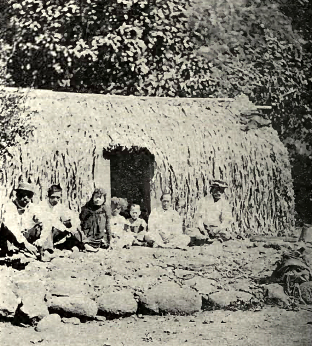
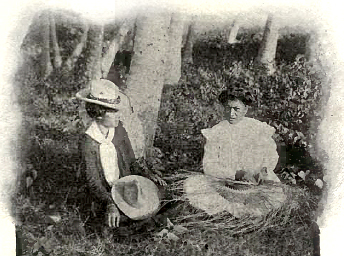
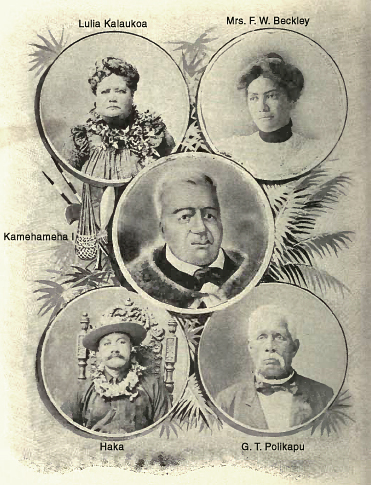

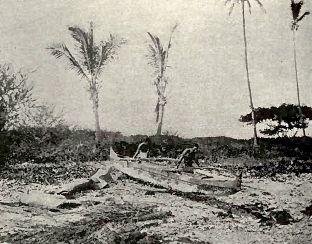
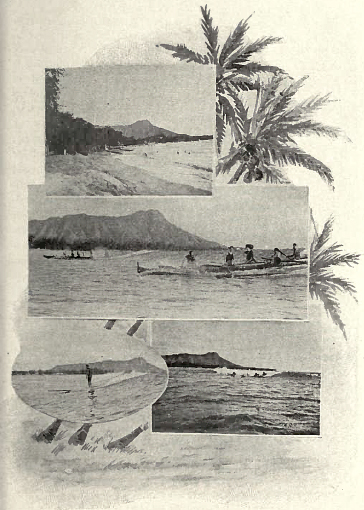
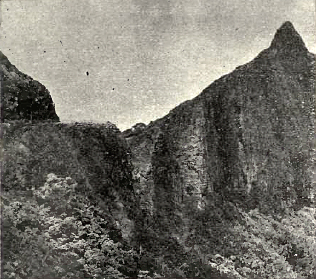
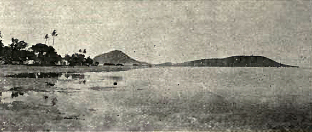
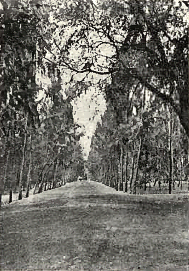

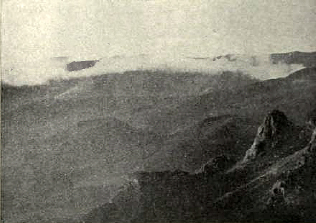
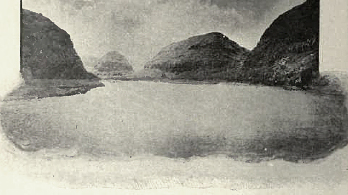


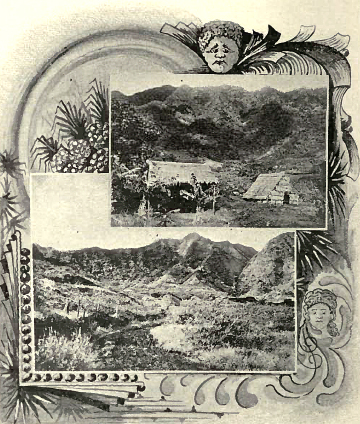
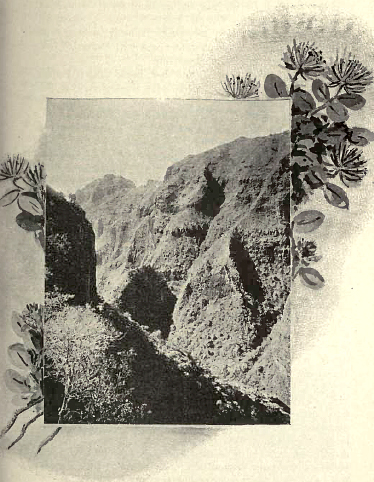
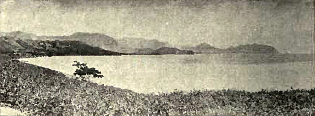
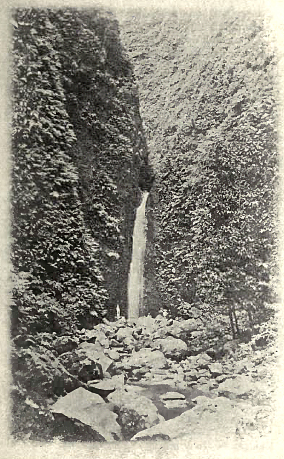
 Waimea
Valley is the spot where Lieutenant Hergest, of the "Deadalus," of
Vancouver's Expedition, was murdered by the natives. It was in a
beautiful valley, the banks of the stream well I cultivated, and
sustaining a very considerable population. The ravages of floods caused
by the denudation of the forest on the surrounding uplands have
destroyed the most of the fertile lands, rendering the banks of what was
once a very beautiful stream, rocky and barren. It was famous among
Hawaiians as the country residence of Kaopulupulu, the famous high
priest, prophet as well as the Prime Minister of the Oahu king, Kahahana.
Waimea
Valley is the spot where Lieutenant Hergest, of the "Deadalus," of
Vancouver's Expedition, was murdered by the natives. It was in a
beautiful valley, the banks of the stream well I cultivated, and
sustaining a very considerable population. The ravages of floods caused
by the denudation of the forest on the surrounding uplands have
destroyed the most of the fertile lands, rendering the banks of what was
once a very beautiful stream, rocky and barren. It was famous among
Hawaiians as the country residence of Kaopulupulu, the famous high
priest, prophet as well as the Prime Minister of the Oahu king, Kahahana.